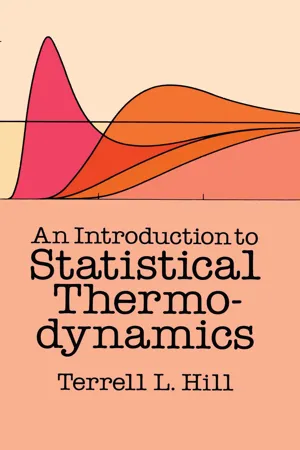
- 544 pages
- English
- ePUB (mobile friendly)
- Available on iOS & Android
An Introduction to Statistical Thermodynamics
About This Book
"A large number of exercises of a broad range of difficulty make this book even more useful…a good addition to the literature on thermodynamics at the undergraduate level." — Philosophical Magazine
Although written on an introductory level, this wide-ranging text provides extensive coverage of topics of current interest in equilibrium statistical mechanics. Indeed, certain traditional topics are given somewhat condensed treatment to allow room for a survey of more recent advances.
The book is divided into four major sections. Part I deals with the principles of quantum statistical mechanics and includes discussions of energy levels, states and eigenfunctions, degeneracy and other topics. Part II examines systems composed of independent molecules or of other independent subsystems. Topics range from ideal monatomic gas and monatomic crystals to polyatomic gas and configuration of polymer molecules and rubber elasticity. An examination of systems of interacting molecules comprises the nine chapters in Part Ill, reviewing such subjects as lattice statistics, imperfect gases and dilute liquid solutions. Part IV covers quantum statistics and includes sections on Fermi-Dirac and Bose-Einstein statistics, photon gas and free-volume theories of quantum liquids.
Each chapter includes problems varying in difficulty — ranging from simple numerical exercises to small-scale "research" propositions. In addition, supplementary reading lists for each chapter invite students to pursue the subject at a more advanced level. Readers are assumed to have studied thermodynamics, calculus, elementary differential equations and elementary quantum mechanics.
Because of the flexibility of the chapter arrangements, this book especially lends itself to use in a one-or two-semester graduate course in chemistry, a one-semester senior or graduate course in physics or an introductory course in statistical mechanics.
Frequently asked questions
Information
Part I
Principles of Quantum Statistical Mechanics
CHAPTER 1
STATISTICAL-MECHANICAL ENSEMBLES AND THERMODYNAMICS
1-1 Introduction.
Table of contents
- DOVER BOOKS ON PHYSICS
- Title Page
- Copyright Page
- Dedication
- PREFACE
- Table of Contents
- Part I - Principles of Quantum Statistical Mechanics
- Part II - Systems Composed of Independent Molecules or Subsystems
- Part III - Systems of Interacting Molecules
- Part IV - Quantum Statistics
- APPENDIX I - NATURAL CONSTANTS
- APPENDIX II - MAXIMUM-TERM METHOD
- APPENDIX III - METHOD OF UNDETERMINED MULTIPLIERS
- APPENDIX IV - THE LENNARD-JONES POTENTIAL
- APPENDIX V - NORMAL COORDINATE ANALYSIS IN A SPECIAL CASE
- APPENDIX VI - VIBRATIONAL FREQUENCY DISTRIBUTION IN A SOLID CONTINUUM
- APPENDIX VII - GENERALIZED COORDINATES
- INDEX
- A CATALOG OF SELECTED DOVER BOOKS IN SCIENCE AND MATHEMATICS